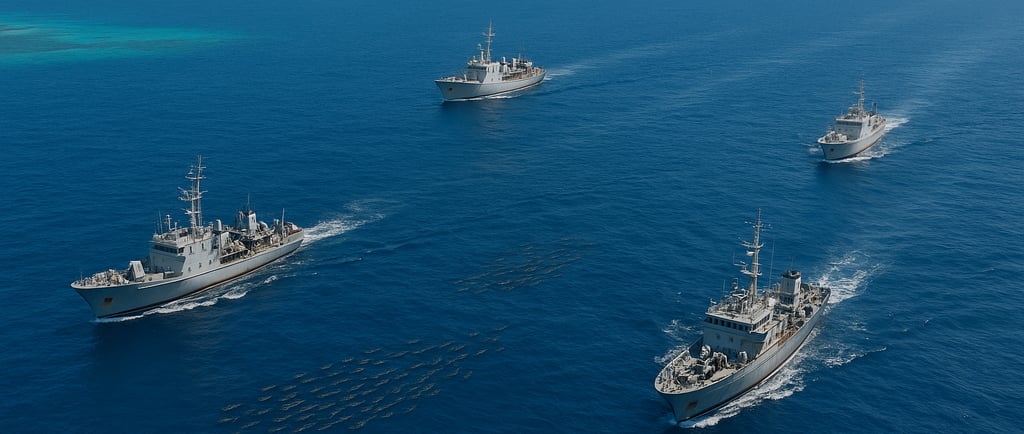Fisheries cooperation in Oceania: the FFA faces maritime powers
OCEANIA
Thomas Dos Remedios
8/27/20256 min read


THE OCEAN AS THE MAIN ASSET OF PACIFIC ISLAND STATES
The island countries of Oceania are characterised by an extreme disproportion between the small size of their land territory and the immensity of their maritime areas. The Republic of Kiribati perfectly illustrates this contrast: its land area is only 811 km², but its Exclusive Economic Zone (EEZ) covers more than 3.5 million km², an area equivalent to that of the European Union. This phenomenon is not isolated: Tuvalu, with only 26 km² of land, controls an EEZ of more than 750,000 km². These vast maritime areas have become the true strategic wealth of the Oceanian micro-states.
The economic value of these EEZs is considerable, as they are home to some of the world's most abundant tuna stocks, particularly skipjack tuna, a species highly prized by the global canning industry, and yellowfin tuna, which is more oriented towards luxury markets. The western and central Pacific now accounts for nearly 60% of global tuna catches, or around 2.5 million tonnes per year.
For states with limited land resources, this maritime bounty is a vital economic pillar. In Tuvalu and Kiribati, the sale of fishing licences accounts for up to 80% of public revenue. In Papua New Guinea, which has an EEZ of 2.4 million km², tuna fishing has become the second largest export after mining products. But this wealth inevitably attracts envy. Lacking naval and technological capabilities, Pacific States found themselves facing a major imbalance in the 1970s: their waters were being exploited on a massive scale by foreign fleets – Japanese, Taiwanese, Korean, then Chinese and American – often without fair compensation. Illegal, unreported and unregulated (IUU) fishing was endemic and deprived governments of essential revenue.
This vulnerable situation gradually raised regional awareness: isolated, these states were doomed to suffer; but united, they could hope to exert influence over external maritime powers. This observation gave rise to the idea of creating a joint organisation capable of defending the interests of island countries on the global fisheries scene.
THE CREATION OF THE FFA : AN INSTRUMENT OF COLLECTIVE SOVEREIGNTY
It was against this backdrop that the Forum Fisheries Agency (FFA) was created in 1979 in Honiara (Solomon Islands), initially comprising 12 member states, which has now grown to 17. Its mission was clear: to coordinate regional fisheries policies in order to strengthen the collective sovereignty of island countries in the face of foreign fleets.
The major innovation introduced by the FFA was the establishment of a multilateral framework for fishing licences, enabling states to collectively negotiate the conditions of access to their EEZs. Rather than signing disadvantageous agreements individually, they decided to join forces. The Nauru Agreement, signed in 1982, marked a decisive step forward: it brings together eight Pacific countries (including Kiribati, Tuvalu, Papua New Guinea and the Solomon Islands) and sets strict rules for access to their waters, notably through the Vessel Day Scheme (VDS). This mechanism allocates a limited number of ‘fishing days’ that countries can sell to foreign companies, creating a regionalised and controlled market.
The economic results have been spectacular: revenues from fishing licences rose from around $60 million in the 1980s to over $500 million in 2018. Papua New Guinea, for example, has been able to use part of this revenue to develop port infrastructure and tuna processing plants, seeking to capture more added value. Conversely, microstates such as Tuvalu and Nauru, which lack industrial capacity, continue to depend almost exclusively on the sale of licences.
But the FFA is not just an economic instrument: it is also a maritime security tool. Its Regional Fisheries Surveillance Centre (RFSC) coordinates aerial and maritime surveillance of EEZs, in collaboration with Australia, New Zealand and sometimes France via its Pacific territories. The annual Kurukuru operation mobilises some 30 patrol boats, aircraft and satellites, and each year intercepts dozens of vessels in violation of the law. In four decades, the FFA has thus become an indispensable institution in the South Pacific, serving as both a tool for economic sovereignty and strategic regulation.
ILLEGAL FISHING AND CLIMATE CHANGE : EXISTENTIAL THREATS
Despite these advances, illegal fishing remains a gaping wound for Oceanian economies. According to a study commissioned by the FFA in 2016, annual losses related to IUU fishing amount to $616 million, or nearly 20% of the total value of catches in the region. There are many fraudulent techniques: manipulation of tracking systems (AIS), transhipment at sea to conceal the origin of the fish, and concealment of excess catches.
For countries whose annual budgets sometimes do not exceed £35 million, such losses are a vital issue. The fight against illegal fishing is therefore as much a matter of economic survival as it is a question of political sovereignty. Furthermore, this pressure on fish stocks threatens food security: in many archipelagos, fish is the main source of protein, and declining stocks directly affect local populations.
This challenge is compounded by another aggravating factor: climate change. Scientific models show that ocean warming could cause tuna stocks to gradually shift towards the eastern Pacific, outside the current EEZs of the Nauru Agreement countries. A World Bank study estimates that by 2050, some island states could lose up to 20% of their fishing revenues due to this redistribution of stocks. This prospect is of particular concern to microstates such as Kiribati and Tuvalu, which have no credible economic alternatives.
Thus, despite the institutional successes of the FFA, the combination of illegal fishing and climate change poses an existential threat to the economic and political viability of Pacific island states.
BETWEEN REGIONAL COOPERATION AND INTERNATIONAL RIVALRIES
The FFA is also a forum where global rivalries come to a head. The United States benefits from a multilateral fishing agreement signed in 1988, which gives it access to the EEZs of several Pacific countries in exchange for a lump sum payment. China, for its part, is multiplying bilateral agreements, financing port infrastructure and processing plants in countries such as the Solomon Islands and Papua New Guinea. Beijing has also strengthened its distant-water fishing fleet, which now numbers more than 3,000 vessels, some of which operate regularly in the Pacific.
This competition is creating tensions between the island states themselves. Some, such as Papua New Guinea, favour bilateral partnerships with China to develop local industry, while others, such as Tuvalu and Kiribati, insist on the importance of preserving regional unity and the effectiveness of the Nauru Agreement. Australia and New Zealand, keen to contain Chinese influence, actively support the FFA with funding, surveillance equipment and training.
The FFA is therefore both a tool of regional sovereignty and a arena for geopolitical competition. For island countries, the challenge is to take advantage of these rivalries without compromising their regional cohesion.
The FFA: a model of maritime governance under pressureThe FFA is also a forum where global rivalries come to a head. The United States benefits from a multilateral fishing agreement signed in 1988, which gives it access to the EEZs of several Pacific countries in exchange for a lump sum payment. China, for its part, is multiplying bilateral agreements, financing port infrastructure and processing plants in countries such as the Solomon Islands and Papua New Guinea. Beijing has also strengthened its distant-water fishing fleet, which now numbers more than 3,000 vessels, some of which operate regularly in the Pacific.
This competition is creating tensions between the island states themselves. Some, such as Papua New Guinea, favour bilateral partnerships with China to develop local industry, while others, such as Tuvalu and Kiribati, insist on the importance of preserving regional unity and the effectiveness of the Nauru Agreement. Australia and New Zealand, keen to contain Chinese influence, actively support the FFA with funding, surveillance equipment and training.
The FFA is therefore both a tool of regional sovereignty and a arena for geopolitical competition. For island countries, the challenge is to take advantage of these rivalries without compromising their regional cohesion.
THE FFA : A MODEL OF MARITIME GOVERNANCE UNDER PRESSURE
In forty years, the FFA has enabled small island states, often marginalised on the international stage, to become full-fledged players in global maritime governance. It has proven that cooperation can transform a structural weakness — the inability to individually exploit and protect their vast EEZs — into a formidable collective strength.
However, the future of this model remains fragile. Member states will need to maintain their unity in the face of bilateral pressure from China, the United States and Taiwan. They will also need to adapt their policies to climate-related changes in fish stocks, or risk seeing their main source of income collapse. Finally, the rise of environmental issues, particularly the protection of marine ecosystems and the fight against overfishing, will force them to reconcile economic imperatives with ecological sustainability.
Thomas Dos Remedios, for SPECTIO
The statements made are solely those of their authors and do not reflect the position of the Think Tank Spectio.
